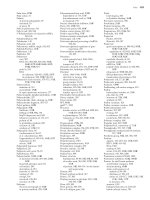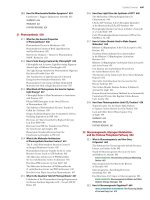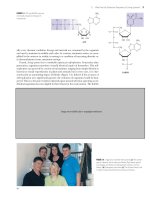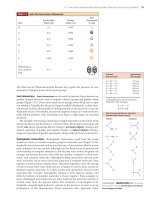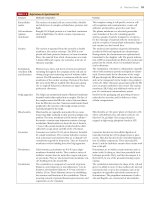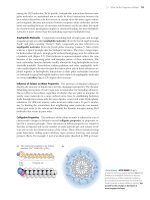Biochemistry, 4th Edition P38 docx
Bạn đang xem bản rút gọn của tài liệu. Xem và tải ngay bản đầy đủ của tài liệu tại đây (1.24 MB, 10 trang )
11.4 Can DNA Adopt Structures of Higher Complexity? 333
of hybridization is a measure of the sequence similarity or relatedness between the
two species. Depending on the conditions of the experiment, about 25% of the
DNA from a human forms hybrids with mouse DNA, implying that some of the nu-
cleotide sequences (genes) in humans are very similar to those in mice (Figure
11.20). Mixed RNAϺDNA hybrids can be created in vitro if single-stranded DNA is
allowed to anneal with RNA copies of itself, such as those formed when genes are
transcribed into mRNA molecules.
Nucleic acid hybridization is a commonly employed procedure in molecular biol-
ogy. First, it can reveal evolutionary relationships. Second, it gives researchers the
power to identify specific genes selectively against a vast background of irrelevant ge-
netic material: An appropriately labeled oligonucleotide or polynucleotide, referred
to as a probe, is constructed so that its sequence is complementary to a target gene.
The probe specifically base pairs with the target gene, allowing identification and sub-
sequent isolation of the gene. Also, the quantitative expression of genes (in terms of
the amount of mRNA synthesized) can be assayed by hybridization experiments.
11.4 Can DNA Adopt Structures of Higher Complexity?
DNA can adopt regular structures of higher complexity in several ways. For example,
many DNA molecules are circular. Most, but not all, bacterial chromosomes are co-
valently closed, circular DNA duplexes, as are most plasmid DNAs. Plasmids are nat-
urally occurring, self-replicating, extrachromosomal DNA molecules found in bacte-
ria; plasmids carry genes specifying novel metabolic capacities advantageous to the
host bacterium. Various animal virus DNAs are circular as well.
Supercoils Are One Kind of Structural Complexity in DNA
In duplex DNA, the two strands are wound about each other once every 10 bp, that
is, once every turn of the helix. Double-stranded circular DNA (or linear DNA du-
plexes whose ends are not free to rotate) form supercoils if the strands are under-
wound (negatively supercoiled) or overwound (positively supercoiled) (Figure 11.21). Un-
derwound duplex DNA has fewer than the normal number of turns, whereas
overwound DNA has more. DNA supercoiling is analogous to twisting or untwisting
a two-stranded rope so that it is torsionally stressed. Negative supercoiling intro-
Native DNA
Heat
Denatured DNA
Nucleation
(second-order)
Slow
Zippering
(first-order)
Fast
Renatured DNA
1 2
FIGURE 11.19 Steps in the thermal denaturation and re-
naturation of DNA.The nucleation phase of the reaction
is a second-order process depending on sequence
alignment of the two strands (1). This process takes
place slowly because it takes time for complementary
sequences to encounter one another in solution and
then align themselves in register. Once the sequences
are aligned, the strands zipper up quickly (2).
Mix
Denature, reanneal
FIGURE 11.20 Solutions of human DNA (red) and mouse
DNA (blue) are mixed and denatured,and the single
strands are allowed to reanneal. About 25% of the human
DNA strands form hybrid duplexes (one red and one blue
strand) with mouse DNA.
334 Chapter 11 Structure of Nucleic Acids
duces a torsional stress that favors unwinding of the right-handed B-DNA double he-
lix, whereas positive supercoiling overwinds such a helix. Both forms of supercoil-
ing compact the DNA so that it sediments faster upon ultracentrifugation or
migrates more rapidly in an electrophoretic gel in comparison to relaxed DNA
(DNA that is not supercoiled). Cellular DNA is almost always negatively supercoiled
(underwound).
Linking Number The basic parameter characterizing supercoiled DNA is the linking
number (L). This is the number of times the two strands are intertwined, and provided
both strands remain covalently intact, L cannot change. In a relaxed circular DNA du-
plex of 400 bp, L is 40 (assuming 10 bp per turn in B-DNA). The linking number for
relaxed DNA is usually taken as the reference parameter and is written as L
0
. L can be
equated to the twist (T) and writhe (W ) of the duplex, where twist is the number of
helical turns and writhe is the number of supercoils:
L ϭ T ϩ W
Figure 11.22 shows the values of T and W for a simple striped circular tube in var-
ious supercoiled forms. In any closed, circular DNA duplex that is relaxed, W ϭ 0.
A relaxed circular DNA of 400 bp has 40 helical turns, T ϭ L ϭ 40. This linking
number can be changed only by breaking one or both strands of the DNA, winding
them tighter or looser, and rejoining the ends. Enzymes capable of carrying out
such reactions are called topoisomerases because they change the topological state
of DNA. Topoisomerases fall into two basic classes: I and II. Topoisomerases of the
I type cut one strand of a DNA double helix, pass the other strand through, and
then rejoin the cut ends. Topoisomerase II enzymes cut both strands of a dsDNA,
pass a region of the DNA duplex between the cut ends, and then rejoin the ends
(Figure 11.23). Topoisomerases are important players in DNA replication (see
Chapter 28).
DNA Gyrase The bacterial enzyme DNA gyrase is a topoisomerase that introduces
negative supercoils into DNA in the manner shown in Figure 11.23. Suppose DNA
gyrase puts four negative supercoils into the 400-bp circular duplex, then W ϭϪ4,
T remains the same, and L ϭ 36 (Figure 11.24). In actuality, the negative supercoils
cause a torsional stress on the molecule, so T tends to decrease; that is, the helix be-
comes a bit unwound, so base pairs are separated. The extreme would be that T
would decrease by 4 and the supercoiling would be removed (T ϭ 36, L ϭ 36, and
(a) (b) (c)
Base of loop
Interwound
supercoil
Toroidal spirals
within supercoil
FIGURE 11.21 Toroidal and interwound varieties of supercoiling. (a) The DNA is coiled in a spiral fashion about
an imaginary toroid (yellow circle). (b) The DNA interwinds and wraps about itself. (c) Supercoils in long, linear
DNA arranged into loops whose ends are restrained—a model for chromosomal DNA. (Adapted from Figures 6.1
and 6.2 in Callandine, C. R.,and Drew, H. R.,1992. Understanding DNA:The Molecule and How It Works. London: Academic Press.)
11.4 Can DNA Adopt Structures of Higher Complexity? 335
W ϭ 0). That is, negative supercoiling has the potential to cause localized unwind-
ing of the DNA double helix so that single-stranded regions (or bubbles) are cre-
ated (Figure 11.24). Usually the real situation is a compromise in which the nega-
tive value of W is reduced, T decreases slightly, and these changes are distributed
over the length of the circular duplex so that no localized unwinding of the helix
ensues. Nevertheless, negative supercoiling makes it easier to separate the DNA
strands and access the information encoded by the nucleotide sequence.
Superhelix Density The difference between the linking number of a DNA and
the linking number of its relaxed form is ⌬L ϭ (L Ϫ L
0
). In our example with four
negative supercoils, ⌬L ϭϪ4. The superhelix density or specific linking difference
is defined as ⌬L/L
0
and is sometimes termed sigma, . For our example,
ϭϪ4/40, or Ϫ0.1. As a ratio, is a measure of supercoiling that is independent
of length. Its sign reflects whether the supercoiling tends to unwind (negative ) or
overwind (positive ) the helix. In other words, the superhelix density states the
number of supercoils per 10 bp, which also is the same as the number of supercoils
per B-DNA repeat. Circular DNA isolated from natural sources is always found in
the underwound, negatively supercoiled state.
Toroidal Supercoiled DNA Negatively supercoiled DNA can arrange into a
toroidal state (Figure 11.25). The toroidal state of negatively supercoiled DNA is sta-
bilized by wrapping around proteins that serve as spools for the DNA “ribbon.” This
toroidal conformation of DNA is found in protein–DNA interactions that are the
L = 0
L = +3
T = 0
W = 0
T = +3
W = 0
T = 0
W = +3
T = +1
W = +2
T = +2
W = +1
L = 0
L =
–
3
T = 0
W = 0
T =
–
3
W = 0
T = 0
W =
–
3
T =
–
1
W =
–
2
T =
–
2
W = 1
(1) (2)
(3) (4)
(5)
(1) (2)
(3) (4)
(5)
(a) Positive supercoiling
(b) Negative supercoiling
FIGURE 11.22 Supercoil topology for a simple circular tube with a single stripe along it. (Adapted from Figures 6.5
and 6.6 in Callandine, C. R.,and Drew, H. R.,1992. Understanding DNA:The Molecule and How It Works. London: Academic Press.)
A
B
(+) node(–) node
DNA is cut and a conformational change
allows the DNA to pass through. Gyrase
religates the DNA and then releases it.
DNA loop
AB
AB
AB
AB
A
B
A
B
(+) node(–) node
(–) node(–) node
A
B
ATP
ADP
+ P
i
1
2
3
4
FIGURE 11.23 A model for the action of bacterial DNA
gyrase (topoisomerase II).The A-subunits cut the DNA
duplex (1) and then hold onto the cut ends (2). Confor-
mational changes in the enzyme allow an intact region
of the DNA duplex to pass between the cut ends.The
cut ends are religated (3), and the covalently complete
DNA duplex is released from the enzyme.The circular
DNA now contains two negative supercoils (4).
336 Chapter 11 Structure of Nucleic Acids
basis of phenomena as diverse as chromosome structure (see Figure 11.27) and
gene expression.
11.5 What Is the Structure of Eukaryotic Chromosomes?
A typical human cell is 20 m in diameter. Its genetic material consists of 23 pairs of ds-
DNA molecules in the form of chromosomes, the average length of which is 3 ϫ
10
9
bp/23 or 1.3 ϫ 10
8
nucleotide pairs. At 0.34 nm/bp in B-DNA, this represents a
DNA molecule 5 cm long. Together, these 46 dsDNA molecules amount to more than
2 m of DNA that must be packaged into a nucleus perhaps 5 m in diameter! Clearly,
the DNA must be condensed by a factor of more than 10
5
. The mechanisms by which
this condensation is achieved are poorly understood at the present time, but it is clear
that the first stage of this condensation is accomplished by neatly wrapping the DNA
around protein spools called nucleosomes. The string of nucleosomes is then coiled to
form a helical filament. Subsequent steps are less clear, but it is believed that this fila-
ment is arranged in loops associated with the nuclear matrix, a skeleton or scaffold of
proteins providing a structural framework within the nucleus (see following discussion).
Nucleosomes Are the Fundamental Structural Unit in Chromatin
The DNA in a eukaryotic cell nucleus during the interphase between cell divisions ex-
ists as a nucleoprotein complex called chromatin. The proteins of chromatin fall into
two classes: histones and nonhistone chromosomal proteins. Histones are abundant
and play an important role in chromatin structure. In contrast, the nonhistone class is
defined by a great variety of different proteins, all of which are involved in genetic reg-
ulation; typically, there are only a few molecules of each per cell. Five distinct histones
are known: H1, H2A, H2B, H3, and H4 (Table 11.2). All five are relatively small, posi-
(a) Relaxed
bp:
L:
T:
W :
400
40
40
0
Gyrase
+ ATP
(nicking and closing)
bp:
L:
T:
W :
400
36
40
–4
bp:
L:
T:
W :
400
36
36
0
Strained:
supertwisted
(b)
Strained:
disrupted base pairs
(c)
FIGURE 11.24 A 400-bp circular DNA molecule in differ-
ent topological states: (a) relaxed, (b) negative super-
coils distributed over the entire length, and (c) negative
supercoils creating a localized single-stranded region.
(a)
T =
–
2, W = 0
(b) (c)
T = 0, W =
–
2 T = 0, W =
–
2
Protein spool
FIGURE 11.25 Supercoiled DNA in a toroidal form wraps readily around protein “spools.”A twisted segment
of linear DNA with two negative supercoils (a) can collapse into a toroidal conformation if its ends are
brought closer together (b). Wrapping the DNA toroid around a protein “spool” stabilizes this conformation
(c). (Adapted from Figure 6.6 in Callandine, C. R., and Drew, H. R.,1992. Understanding DNA: The Molecule and How It Works.
London: Academic Press.)
Ratio of
Histone Lysine to Arginine Size (kD) Copies per Nucleosome
H1 59/3 21.2 1 (not in core)
H2A 13/13 14.1 2
H2B 20/8 13.1 2
H3 13/17 15.1 2
H4 11/14 11.4 2
TABLE 11.2
Properties of Histones
11.5 What Is the Structure of Eukaryotic Chromosomes? 337
tively charged, arginine- or lysine-rich proteins that interact via ionic bonds with the
negatively charged phosphate groups on the polynucleotide backbone. Pairs of his-
tones H2A, H2B, H3, and H4 aggregate to form octameric core structures, and the
DNA helix is wound about these core octamers, creating nucleosomes.
If chromatin is swelled suddenly in water and prepared for viewing in the electron
microscope, the nucleosomes are evident as “beads on a string,” dsDNA being the
string. The structure of the histone octamer core wrapped with DNA has been solved
by T. J. Richmond and collaborators (Figure 11.26). The core octamer has surface
landmarks that guide the course of the DNA; 147 bp of B-DNA in a flat, left-handed
superhelical conformation make 1.6 turns around the histone core (Figure 11.26),
which itself is a protein superhelix consisting of a spiral array of the four histone
dimers. Histone H1, a three-domain protein, organizes an additional 29–43 bp of
DNA and links consecutive nucleosomes. Each complete nucleosome unit contains
176–190 bp of DNA. The N-terminal tails of histones H3 and H4 are accessible on the
surface of the nucleosome. Lysine and serine residues in these tails can be covalently
modified in myriad ways (lysines may be acetylated, methylated, or ubiquitinated; ser-
ines may be phosphorylated). These modifications play an important role in chro-
matin dynamics and gene expression (see Chapter 29).
Higher-Order Structural Organization of Chromatin Gives Rise
to Chromosomes
A higher order of chromatin structure is created when the array of nucleosomes,
in their characteristic beads-on-a-string motif, is wound in the fashion of a solenoid
(Figure 11.27). One structure proposed for the resulting 30-nm fiber has a diameter
of 33 nm and a height of 33 nm. It is formed by 22 nucleosomes arrayed helically. Cur-
rent evidence indicates that this 30-nm filament then forms long DNA loops of variable
length, each containing on average between 60,000 and 150,000 bp. Electron micro-
scopic analysis of human chromosome 4 suggests that 18 such loops are then arranged
radially about the circumference of a single turn to form a miniband unit of the chro-
mosome. According to this model, approximately 10
6
of these minibands are arranged
along a central axis in each of the chromatids of human chromosome 4 that form at
mitosis (Figure 11.27). Despite intensive study, much about the higher-order structure
of chromosomes remains to be discovered.
(a) (b)
FIGURE 11.26 The nucleosome core particle wrapped with 1.65 turns of DNA (147 bp). The DNA is shown as a
blue and orange double helix.The four types of core histones are shown as different colors.(left) View down the
axis of the nucleosome; (right) view perpendicular to the axis (pdb id ϭ 1AOI). (Adapted from Luger,K., et al., 1997.
Crystal structure of the nucleosome core particle at 2.8 Å resolution.Nature 389:251–260. Photos courtesy of T. J. Richmond,
ETH-Hönggerberg, Zurich, Switzerland.)
338 Chapter 11 Structure of Nucleic Acids
SMC Proteins Establish Chromosome Organization and Mediate
Chromosome Dynamics
Although the details remain a mystery, we know that the process of chromatin or-
ganization into chromosomes involves SMC proteins. SMC stands for structural
maintenance of chromosomes. SMC proteins are members of the nonhistone chro-
mosomal protein class. SMC proteins form a large superfamily of ATPases involved
in higher-order chromosome organization and dynamics. SMC protein representa-
tives are found in all forms of life—archaea, bacteria, and eukaryotes. Chromoso-
mal dynamics includes chromosome condensation, sister chromatid cohesion,
genetic recombination, and DNA repair, as well as other phenomena. SMC proteins
have a characteristic five-domain organization, consisting of an N-terminal globular
ATP-binding domain, a rodlike dimerization domain involved in coiled coil
DNA double helix
2 nm
“Beads on a string” chromatin form
10 nm
Solenoid (six nucleosomes per turn)
30 nm
Loops (50 turns per loop)
~ 0.25 m
Miniband (18 loops)
Matrix
0.84 m
Chromosome (stacked minibands)
0.84 m
(a)
(b)
(c)
(d)
(e)
FIGURE 11.27 A model for chromosome structure, hu-
man chromosome 4.
11.6 Can Nucleic Acids Be Synthesized Chemically? 339
formation, a flexible hinge region, another rodlike and coiled coil–forming region,
and finally a C-terminal globular domain termed DA for its DNA-binding and
ATPase abilities (Figure 11.28). Five subgroups of SMC proteins are found in eu-
karyotes, and functional SMC proteins are heterodimers. SMC2/SMC4 het-
erodimers are essential for chromatin condensation as part of condensin com-
plexes; SMC1/SMC3 heterodimers act in sister chromatid cohesion as part of
cohesin complexes. Current models of SMC protein function suggest that V-shaped
heterodimers bind to DNA through their DA domains and mediate chromosomal
dynamics in an ATP-dependent manner. The flexible hinge region of each SMC
subunit is located at the point of the V, and hinge-bending motions allow the DNA-
binding parts of the two globular heads to move closer together, compacting the
DNA into a higher-order structure (Figure 11.28).
11.6 Can Nucleic Acids Be Synthesized Chemically?
Laboratory synthesis of oligonucleotide chains of defined sequence presents some of
the same problems encountered in chemical synthesis of polypeptides (see Chapter
5). First, functional groups on the monomeric units (in this case, bases) are reactive
under conditions of polymerization and therefore must be protected by blocking
agents. Second, to generate the desired sequence, a phosphodiester bridge must be
formed between the 3Ј-O of one nucleotide (B) and the 5Ј-O of the preceding one
(A) in a way that precludes the unwanted bridging of the 3Ј-O of A with the 5Ј-O of
B. Finally, recoveries at each step must be high so that overall yields in the multistep
process are acceptable. As in peptide synthesis (see Chapter 5), orthogonal solid-
phase methods are used to overcome some of these problems. Commercially available
(a) SMC protein architecture
SMC monomer
(b) Chromatin
condensation
N–terminal
ATP-binding
domain
DA domain
Hinge
region
SMC2/SMC4
heterodimer
DNA
DNA
Coiled coil
domains
SMC heterodimer
FIGURE 11.28 SMC protein architecture and function.
(a) SMC protein architecture. SMC proteins range from
115 to 165 kD in size.(b) SMC protein function.SMC pro-
teins are reminiscent of motor proteins. Illustrated in (b) is
a condensation of DNA into a coiled arrangement
through SMC2/SMC4-mediated interactions.
340 Chapter 11 Structure of Nucleic Acids
automated instruments, called DNA synthesizers or “gene machines,” are capable of
carrying out the synthesis of oligonucleotides of 150 bases or more.
Phosphoramidite Chemistry Is Used to Form Oligonucleotides
from Nucleotides
Phosphoramidite chemistry is currently the accepted method of oligonucleotide syn-
thesis. The general strategy involves the sequential addition of nucleotide units as
nucleoside phosphoramidite derivatives to a nucleoside covalently attached to the insol-
uble resin. Excess reagents, starting materials, and side products are removed after
each step by filtration. After the desired oligonucleotide has been formed, it is freed
of all blocking groups, hydrolyzed from the resin, and purified by gel electrophore-
sis. The four-step cycle is shown in Figure 11.29. Chemical synthesis takes place in the
3Ј→5Ј direction (the reverse of the biological polymerization direction).
Genes Can Be Synthesized Chemically
It is possible to synthesize genes using phosphoramidite chemistry (Table 11.3). Be-
cause protein-coding genes are characteristically much larger than the 150-bp prac-
tical limit on oligonucleotide synthesis, their synthesis involves joining a series of
oligonucleotides to assemble the overall sequence.
HUMAN BIOCHEMISTRY
Telomeres and Tumors
Eukaryotic chromosomes are linear. The ends of chromosomes
have specialized structures known as telomeres. The telomeres of
virtually all eukaryotic chromosomes consist of short, tandemly
repeated nucleotide sequences at the ends of the chromosomal
DNA. For example, the telomeres of human germline (sperm and
egg) cells contain between 1000 and 1700 copies of the hexam-
eric repeat TTAGGG (see accompanying figure). Telomeres con-
tribute to the maintenance of chromosomal integrity by protect-
ing against DNA degradation or rearrangement. Telomeres are
added to the ends of chromosomal DNA by an RNA-containing
enzyme known as telomerase (see Chapter 28). In human telom-
erase, the ribonucleotide part is a 962-nucleotide-long RNA.
Telomerase is an unusual DNA polymerase that was discovered in
1985 by Elizabeth Blackburn and Carol Greider of the University
of California, San Francisco. However, most normal somatic cells
lack telomerase. Consequently, upon every cycle of cell division
when the cell replicates its DNA, about 50-nucleotide segments
are lost from the end of each telomere. Thus, over time, the
telomeres of somatic cells in animals become shorter and shorter,
eventually leading to chromosome instability and cell death. This
phenomenon has led some scientists to espouse a “telomere the-
ory of aging” that implicates telomere shortening as the principal
factor in cell, tissue, and even organism aging. Interestingly, can-
cer cells appear “immortal” because they continue to reproduce
indefinitely. A survey of 20 different tumor types by Geron Cor-
poration of Menlo Park, California, revealed that all contained
telomerase activity.
5'-CCTAACCCTAA
3'-GGGATTGGGATTGGGATT
TTAGGGTTAGGGTTAGGG–3'
AATCCC –5'
TTAGGGTTAGGG
AATCCC
(a)
3'-
5'-
3'
5'
Site of telomerase
DNA polymerase
function
(b)
Telomerase
protein
Telomerase
RNA
C
AAUCCCAAUC
ᮤ
(a) Telomeres on human chromosomes.TTAGGG tandem repeats are
attached to the 3Ј-ends of the DNA strands and are paired with the comple-
mentary sequence 3Ј-AATCCC-5Ј on the other DNA strand.Thus, a G-rich region
is created at the 3Ј-end of each DNA strand, and a C-rich region is created at the
5Ј-end of each DNA strand.Typically, at each end of the chromosome, the G-rich
strand protrudes 12 to 16 nucleotides beyond its complementary C-rich strand.
(b) The ribonucleic acid of human telomerase serves as the template for the
DNA polymerase activity of telomerase. Nucleotides 46 to 56 of this RNA are
CUAACCCUAAC and provide the template function for the telomerase-catalyzed
addition of TTAGGG units to the 3Ј-end of a DNA strand.
11.7 What Are the Secondary and Tertiary Structures of RNA? 341
11.7 What Are the Secondary and Tertiary Structures
of RNA?
RNA molecules (see Chapter 10) are typically single-stranded. The course of a
single-stranded RNA in three-dimensional space conceivably would have six de-
grees of freedom per nucleotide, represented by rotation about each of the six sin-
gle bonds along the sugar–phosphate backbone per nucleotide unit. (Rotation
about the -glycosidic bond creates a seventh degree of freedom in terms of the
total conformational possibilities at each nucleotide.) Compare this situation with
DNA, whose separated strands would obviously enjoy the same degrees of freedom.
However, the double-stranded nature of DNA imposes great constraint on its con-
formational possibilities. Compared to dsDNA, an RNA molecule has a much
greater number of conformational possibilities. Intramolecular interactions and
other stabilizing influences limit these possibilities, but the higher-order structure
of RNA remains an area for fruitful scientific discovery.
Adenine
nucleotide
NH
2
+
C
CH
3
C Cl
N
N
N
N
R
Benzoyl
chloride
HCl
+
NH
N
N
N
N
R
C
O
N-benzoyl adenine
derivative
N
N
N
N
H
2
N
Guanine
nucleotide
+
HC
Cl
Isobutyryl
chloride
HCl
+
N
N
N
N
R
N-isobutyryl
guanine
derivative
NH
CO
CH
H
3
C
CH
3
H
O
O
O
O
R
CH
3
(a)
O
CH
2
Base
1
O
DMTr
DMTr
Detritylation by H
+
(trichloroacetic acid)
O
CH
2
Base
1
OR
OH
C OCH
3
CH
3
O
Dimethoxytrityl (DMTr)
OR
Solid support (bead)
1
(b) BLOCKING GROUPS:
FIGURE 11.29 Solid-phase oligonucleotide synthesis.The four-step cycle starts with the first base in nucleoside
form attached by its 3Ј-OH group to an insoluble support. Its 5Ј-OH is blocked with a dimethoxytrityl (DMTr)
group (a). If the base has reactive ONH
2
functions, as in A,G, or C,then N-benzoyl or N-isobutyryl derivatives are
used to prevent their reaction (b). In step 1, the DMTr protecting group is removed by trichloroacetic acid treat-
ment. Step 2 is the coupling step:The second base is added in the form of a nucleoside phosphoramidite deriv-
ative whose 5Ј-OH bears a DMTr blocking group so it cannot polymerize with itself (c). continued
Gene Size (bp)
tRNA 126
␣-Interferon 542
Secretin 81
␥-Interferon 453
Rhodopsin 1057
Proenkephalin 77
Connective tissue activating
peptide III 280
Lysozyme 385
Tissue plasminogen activator 1610
c-Ha-ras 576
RNase T1 324
Cytochrome b
5
330
Bovine intestinal Ca-binding
protein 298
Hirudin 226
RNase A 375
TABLE 11.3
Some Chemically Synthesized
Genes
342 Chapter 11 Structure of Nucleic Acids
Although single-stranded, RNA molecules are rich in double-stranded regions
that form when complementary sequences within the chain come together and join
via intrastrand base pairing. These interactions create hairpin stem-loop structures,
in which the base-paired regions form the stem and the unpaired regions between
base pairs are the loop, as in Figures 11.30 and 11.31. Paired regions of RNA can-
not form B-DNA-type double helices because the RNA 2Ј-OH groups are a steric
hindrance to this conformation. Instead, these paired regions adopt a conforma-
tion similar to the A-form of DNA, having about 11 bp per turn, with the bases
+
N
HC
HC
OR
O
CH
2
Base
2
O
O
P
H
3
CO
CH
3
CH
3
H
3
C
O
CH
2
Base
1
OH
OR
HN
CH
3
H
3
C
HC
H
H
N
N
N
N
OCH
3
O
CH
2
Base
2
O
O
P
O
CH
2
Base
1
O
Phosphoramidite derivative
of nucleotides 2
OR
OCH
3
O
CH
2
Base
2
O
O
P
O
CH
2
Base
1
O
O
I
2
; H
2
O
oxidation of
trivalent phosphorus
Next nucleotide added following
detritylation as in step 1. Cycle
repeated to synthesize oligonucleotide
of desired sequence and length.
Cleavage of oligonucleotide
from solid support and
removal of N-benzoyl and
N-isobutyryl blocking groups.
NH
4
OH
treatment
Desired
product
Phosphite-linked bases
(dinucleotide)
CH
3
CH
3
HC
CH
3
Phosphate-linked bases
(dinucleotide)
Catalyzed by weak
acid tetrazole
2
Capping
3
4
(c)
DMTr DMTr
DMTr
FIGURE 11.29 continued In step 2, the presence of a weak acid, such as tetrazole, activates the phospho-
ramidite, and it rapidly reacts with the free 5Ј-OH of N-1, forming a dinucleotide linked by a phosphite group.
Unreacted free 5Ј-OHs of N-1 are blocked from further participation in the polymerization process by acetyla-
tion with acetic anhydride in step 3, referred to as capping. In step 4, the phosphite linkage between N-1 and
N-2 is oxidized by aqueous iodine (I
2
) to form the desired more stable phosphate group. Subsequent cycles
add successive residues to the resin-immobilized chain.When the chain is complete, it is cleaved from the sup-
port with NH
4
OH, which also removes the N-benzoyl– and N-isobutyryl–protecting groups from the amino
functions on the A, G, and C residues.
